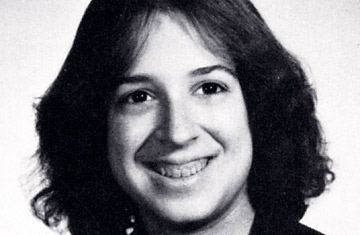
Elena Kagan's Princeton University yearbook portrait
Supreme Court nominee Elena Kagan's undergraduate thesis submitted at Princeton University in 1981, was a detailed history of the rise and fall of New York's Socialist Party in the early 20th Century. It's an impressive work for a young person — and it is sparking questions about the extent to which the young Kagan had embraced left-wing views.
"This proves Elena Kagan is an open and avowed socialist," conservative writer Erick Erickson declared on his RedState blog, which posted a copy of the 130-page thesis on Thursday evening. Ann Althouse, another conservative blogger, wasn't so sure. "I think there is a lot more evidence that Kagan knows how to please and win the favor of those with the power to advance her career," she chimed in. "I'm just going to guess — correct me if I'm wrong — that in 1981, Princeton students were able to discern that their history professors liked socialism."
Most of the document is a remarkably clear and cogent account of the deeply tangled and confusing politics that divided the left from the far left a century ago. Focusing on the New York City socialists, Kagan began with a question that historians had been asking for decades: Why didn't socialism happen in the United States as it did throughout Europe?
Her answer shows that she was following her heart when she went from Princeton to Harvard Law School, and from there made her way into the government. Rather than pursuing cultural or economic explanations, as some historians have done, Kagan burrowed into the legal and political disputes that divided the socialists. One wing sought reform of the capitalist system, while another wing sought to overthrow the system entirely.
Party leader Morris Hillquit was an architect of the gradual reform strategy. His philosophy was that the "perfection of American society ... would result from a long series of political and economic reforms, each of which would add a bit of socialism to the nation," Kagan wrote. "Socialists had to constantly work for the enactment of further reforms: wages and hours legislation, women's suffrage, workingmen's insurance. In this way, more socialist threads would be added to the fabric of American life."
According to Kagan, Hillquit believed this would make the Socialist Party popular at the polls. Then, by gaining office, Socialists would "initiate still further reforms, each of which would represent another gradual — indeed almost imperceptible — step along the road to a completely socialist order."
For a while, the strategy seemed to be working. American Socialists enjoyed a period of rising popularity when the reformers were in charge, sending two party members to Congress — Wisconsin's Victor Berger in 1910 and New York's Meyer London in 1914.
The crisis for American socialism, Kagan writes, came with the 1917 Bolshevik revolution in Russia. For radicals in the American movement, this seemed to be the start of something big — and they should join Russia's Leninists in a worldwide uprising to crush capitalism by violence. Their militant demands prompted years of internal warfare as factions battled factions and splinter groups splintered into smaller splinters.
If there is anything to object to in Kagan's narrative, it is that she focused so intently on the capital-S Socialists that she mostly missed what happened to the small-s socialism of Morris Hillquit. She pays only passing attention to the fact that New York's Democratic Party — then known as Tammany Hall — noticed the rising popularity of Hillquit's gradual reforms, and plucked a piece of the action. Issues such as labor rights, women's suffrage, and workplace safety were woven into the Democratic platform and helped to vault Tammany's Al Smith into the governor's office.
In 1932, that agenda went national with the election of President Franklin D. Roosevelt.
Kagan's critics will focus on her conclusion, however — which can be read as a personal statement in support of the socialist dream. "The story is a sad but also a chastening one for those who, more than half a century after socialism's decline, still wish to change America," she wrote. "American radicals cannot afford to become their own worst enemies. In unity lies their only hope."
People will make of that what they will. But if Kagan ultimately is confirmed, she won't be the first Supreme Court justice with a past immersed in the history of New York's labor movement and socialist politics. As her thesis points out, that was a milieu in which the legendary Louis Brandeis was formed.
